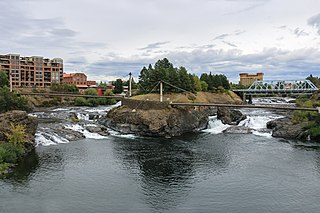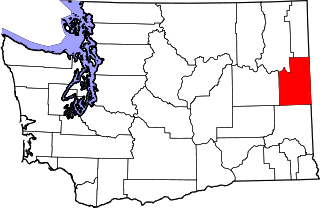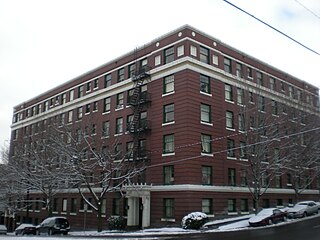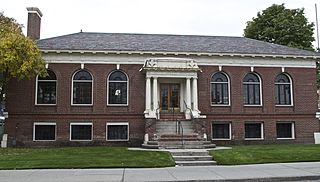
Cheney is a city in Spokane County, Washington, United States. The full-time resident population was 10,590 as of 2010 census. Eastern Washington University is located in Cheney. When classes are in session at EWU, the city's population reaches approximately 17,600 people on a temporary basis.

Spokane is the largest city and county seat of Spokane County, Washington, United States. It is in eastern Washington, along the Spokane River, adjacent to the Selkirk Mountains, and west of the Rocky Mountain foothills, 92 miles (148 km) south of the Canadian border, 18 miles (30 km) west of the Washington–Idaho border, and 279 miles (449 km) east of Seattle, along I-90.
Star Theatre or Star Theater may refer to:

Felts Field is a public airport in the northwest United States, located five miles (8 km) northeast of downtown Spokane, in Spokane County, Washington. It is owned by Spokane City-County.

Willis Alexander Ritchie, also known as W.A.Ritchie, was an architect whose career began in Ohio and Kansas, but reached maturity in Seattle and Spokane, Washington.

This is a list of the National Register of Historic Places listings in Spokane County, Washington.
Barnett House may refer to:
Northern Pacific Depot, Northern Pacific Railway Depot, Northern Pacific Passenger Depot, Northern Pacific Railroad Depot, or Northern Pacific Railway Passenger Depot may refer to the following stations in the United States:
Commercial Block may refer to:
Miller Block may refer to:

The California Area Public Library is the public library serving California, Pennsylvania and is a branch of the Washington County Library System. The library is located in the former Pennsylvania Railroad Passenger Station, which was listed on the National Register of Historic Places in 1979.

Albert Held was an American architect. He was born in New Ulm, Minnesota on March 25, 1866, and studied for two years at the University of Minnesota. He first worked as a draftsman
Clarence Ferris White was a prolific architect in the Pacific Northwest. He designed more than 1,100 buildings, including 63 schools, in the State of Washington. His largest project was the design of the company town of Potlatch, Idaho in 1905. Several of his works are listed on the United States National Register of Historic Places.

Julius Zittel was an architect in Washington State. He was a draftsman at Herman Preusse firm and then became a partner at their firm. He became Washington's state architect.

The Spokane Public Library - East Side Branch is a historic building in East Central, Spokane, Washington. It was designed by architect Albert Held, and built in 1913 with a donation from Andrew Carnegie. It was used as a library until 1980. It has been listed on the National Register of Historic Places since August 3, 1982.

The Spokane Public Library - Heath Branch is a historic building in the Logan neighborhood of Spokane, Washington. It was designed by architect Julius Zittel, and built in 1914 with $35,000 from Andrew Carnegie. It has been listed on the National Register of Historic Places since August 3, 1982.

The Spokane Public Library - North Monroe Branch is a historic building in the Emerson/Garfield neighborhood of Spokane, Washington. It was designed by Albert Held, and built in 1914 with $17,500 from Andrew Carnegie. It has been listed on the National Register of Historic Places since August 3, 1982.

Spokane and its neighborhoods contain a patchwork of architectural styles that give them a distinct identity and illustrate the changes throughout the city's history. Spokane has a rich architectural history for a western city of its size and much of it is a product of its circumstances at the turn of the 20th century when as a rapidly growing city, the Great Fire of 1889 destroyed 32 blocks of the city center which was quickly rebuilt in a more grand fashion by a community flush with money coming from regional mining districts. Many of the architects that found work in the city and building on the blank slate of the downtown commercial district became highly esteemed architects such as Kirtland Cutter, who has been credited with giving the city a distinctive character. In particular, the city has a high concentration of Romanesque Revival style institutional and commercial buildings and American Craftsman bungalow residences. The architecture of Spokane gained national recognition in industry publications in the early 20th century.
This page is based on this
Wikipedia article Text is available under the
CC BY-SA 4.0 license; additional terms may apply.
Images, videos and audio are available under their respective licenses.











